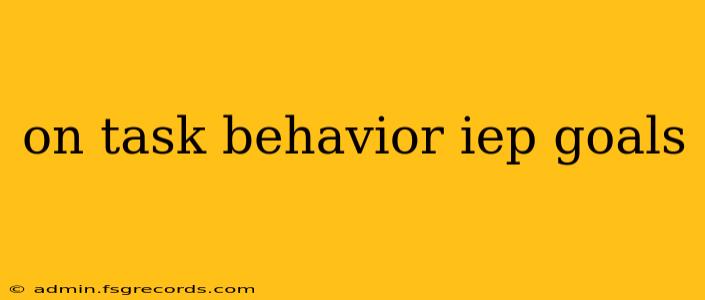Creating effective Individualized Education Program (IEP) goals for on-task behavior requires a nuanced understanding of the student's specific needs and challenges. This guide provides a framework for developing measurable, achievable, and relevant goals that promote improved focus and engagement in the classroom and beyond.
Understanding On-Task Behavior Challenges
Before crafting IEP goals, it's crucial to accurately identify the root causes of a student's difficulty staying on task. These can vary widely, including:
- Attention Deficit Hyperactivity Disorder (ADHD): Students with ADHD often struggle with sustained attention, impulsivity, and hyperactivity, making it difficult to remain focused on assigned tasks.
- Learning Disabilities: Specific learning disabilities can impact a student's ability to understand instructions, process information, and complete tasks efficiently, leading to frustration and off-task behavior.
- Emotional and Behavioral Disorders: Anxiety, depression, or other emotional challenges can significantly disrupt a student's ability to concentrate and participate in class.
- Sensory Processing Issues: Over- or under-sensitivity to sensory input (light, sound, touch) can be distracting and make it hard for a student to focus.
- Lack of Engagement: If a student finds the material uninteresting or irrelevant, they may disengage and become off-task.
Developing Measurable IEP Goals for On-Task Behavior
Effective IEP goals must be SMART: Specific, Measurable, Achievable, Relevant, and Time-Bound. Here are examples of well-written IEP goals targeting different aspects of on-task behavior:
1. Goal Focusing on Duration of On-Task Behavior:
- Specific: Increase the duration of independent seatwork.
- Measurable: The student will remain on task during independent seatwork for at least 15 minutes, as measured by direct observation using a data sheet, for 80% of sessions over four consecutive weeks.
- Achievable: This goal is achievable through gradual increases in the expected duration and utilizing strategies such as frequent short breaks and positive reinforcement.
- Relevant: This goal directly addresses the student's difficulty staying focused on independent work.
- Time-Bound: The goal will be evaluated over four consecutive weeks.
2. Goal Focusing on Reducing Distractibility:
- Specific: Reduce the frequency of off-task behaviors during instructional time.
- Measurable: The student will exhibit no more than two instances of off-task behavior (e.g., talking out of turn, getting out of seat) during a 45-minute instructional period, as measured by teacher observation, for 80% of sessions over four consecutive weeks.
- Achievable: This goal is achievable through the implementation of strategies like preferential seating, visual cues, and positive reinforcement.
- Relevant: This goal addresses the student's tendency to be easily distracted in the classroom.
- Time-Bound: The goal will be evaluated over four consecutive weeks.
3. Goal Focusing on Task Completion:
- Specific: Improve completion rate of assigned classroom tasks.
- Measurable: The student will independently complete at least 80% of assigned in-class worksheets and assignments, as documented by teacher records, for four consecutive weeks.
- Achievable: This goal is achievable through task analysis, breaking down large tasks into smaller steps, and providing adequate support.
- Relevant: This goal addresses the student's difficulty finishing tasks within the allotted time.
- Time-Bound: The goal will be evaluated over four consecutive weeks.
Strategies to Support On-Task Behavior Goals
Successful implementation of IEP goals requires a multi-faceted approach involving:
- Environmental Modifications: Adjusting seating arrangements, minimizing distractions, and providing a quiet workspace.
- Instructional Strategies: Breaking down tasks, providing clear instructions, utilizing visual aids, and incorporating movement breaks.
- Behavioral Interventions: Positive reinforcement systems, token economies, and proactive strategies to address off-task behavior.
- Collaboration: Open communication between educators, parents, and other relevant professionals.
Regularly Monitoring Progress and Adapting Goals
Regularly monitor the student's progress toward their IEP goals. This requires consistent data collection and analysis to determine the effectiveness of interventions. Be prepared to adjust goals and strategies as needed to ensure the student's success. This continuous monitoring and adaptation are essential for creating effective and supportive IEP goals that truly promote on-task behavior.
This guide provides a starting point. Always consult with educational professionals and the student's IEP team to develop individualized goals that best meet the student's unique needs. Remember that creating a supportive and understanding learning environment is paramount in fostering on-task behavior and academic success.

